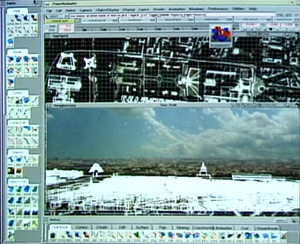
|
The explosion scenes in the movie Armageddon were caused by explosives meteor impacts, rather than caused by explosives. There are several scenes in the movie showing meteor impacts and the destruction they cause, but the scene that stands out is the destruction of Paris. The job of creating the Paris destruction sequence was given to a company called Dream Quest Images, who are based in California.
|
The "Paris Destruction" Scene |
||||
|
Making the Scene |
|||||
|
Pre-Visualisation |
Before any production work could start, the actual sequence had to be worked out and approved. The pre-visualisation of the scene was done using an animation sequence. Although basic, the clip was enough to get the go ahead. The actual impact and shockwave in the scene were actually created using live action, although CG elements were added to create the overall effect. |
||||
|
To create the effect for the shockwave blast approaching the camera, concentric rings of Primacord were placed that detonated at 5000th of a second apart. The base for the concentric rings was constructed by building a flat topped island. The island was built from sand and was about 100 feet long by 9 feet deep. The island was built with a slight gradient of about 8 degrees so that the camera would be pointing towards the sky when the blast approached. To create a solid flat foundation, steel sheets were laid and welded together on top of the sand. The steel was used to prevent the blast from penetrating downwards and to make sure the blast was projected upwards. Once the steel sheets were in place, the concentric rings of Primacord could be laid. About 6000 feet of Primacord were used to create the 80 concentric rings. To enhance the effect of debris being blown into the air, the concentric rings were covered with about a foot of sand and mulch. The detonation of each ring of Primacord was managed by a spcially built computer controlled relay unit, that could handle upto 96 individual switches. A CG animatic was created that interfaced to the control unit and was used to trigger each ring at a specified time. |
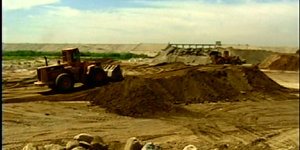
Island Construction 
Rings of Primacord 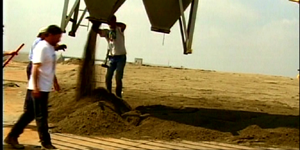
Final Layer |
||||
|
Once triggered, the time for all the Primacord rings to detonate was just 0.4 seconds. But, using a very high speed camera, the shot was slowed down to give a duration of about 15 seconds. |
|||||
|
|||||
|
The initial explosion for the impact of the meteor was created by detonating aluminium powder. This powder produces a large white flash. The flash can be seen clearly in the time adjusted shot above. |
|||||
|
The CG elements of the shot involved recreating Paris inside Maya. Using aerial and satellite imagery, the major buildings were created. The majority of the buildings were just simple cubes, as a photograph of Paris was projected onto the shapes, so no detail needed to be created on the geometry. Although the projected photograph was taken from the Eiffel Tower, the tower itself was actually visible in the shot. This was accurately modelled in Maya as its destruction involved it breaking apart in a realistic manor. |
|||||
Creating Paris in Maya (Notice the heavily customised interface) |
|||||
|
Particles in Action |
To produce the destruction of each of the buildings in the Maya scene, an animated expanding cylinder was used to represent the front of the blast shockwave (see the above Pre-Visualisation clip). When the cylinder collided with a building, it triggered a particle and dynamics effect to give the impression that the building was disintegrating. The final construction of the scene involved about 50 different layers. These layers were composited together by one person who took about a week and a half to complete the final sequence. |
||||
|
The Paris aftermath shot was created by a company called Matte World Digital. They had the responsibility of creating a convincing aerial shot of Paris after the metero impact. The shot involved taking an aerial photopgraph of Paris and then producing a digital matte painting showing the destruction. Various CG elements were added to the matte painting, including smoke and fire. |
|||||
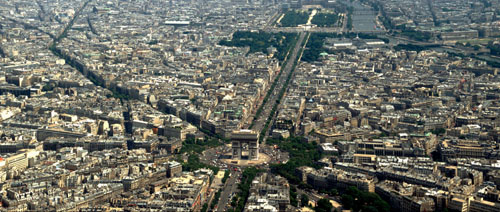
Original Paris Photograph |
|||||
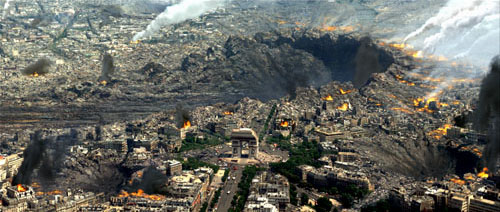
Digital Matte Painting with CG Elements |
|||||
|
|||||


